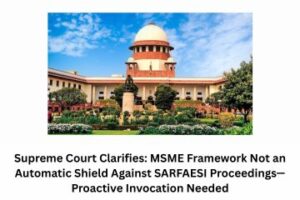Competition Ethics: An Exclusion and Foreclosure of Anti-Competitive Agreements
Written By: Neetu Lather
Introduction
The main objectives of the Competition Act, 2002 are to develop healthy & fair competition in the market & prohibit anti-competitive agreements that cause or are likely to cause an appreciable adverse effect on competition. The Act under Section 3(1) prevents any enterprise or association from entering into any agreement which causes or is likely to cause an AAEC within India.
Competition ethics
Competition is the act of the sellers individually seeking to attain the customer’s confidence to gain profits or market share. Business ethics as to achieve competitive advantage involving building effective relationships with a company’s stakeholders based on its integrity that maintains such relationships. Business relations are based on faith & mutual respect. The business entities must be fair for a market economy to grow at a genuine rate. Naturally, all the competitors will try to gain a good image in consumer’s eyes to increase market share by continuously trying to reduce prices, improve the quality of the goods & discover more efficient & profitable means of production. While ethical issues stand on the difference between right & wrong, legal issues stand on laws.
Many laws are framed by keeping ethical issues in mind to protect individual rights & freedoms. On the other side, there are laws, which can be used in unethical ways. It is unethical & illegal for businesses to mutually act in ways, which can limit competition, lead to an increase in the price level or restrain other businesses from entering the market. Some mutual decisions are so harmful to competition that they are almost always considered illegal. These include agreements to rig bids, fix prices, or divide markets.
Anti-Competitive Agreements
Anti-Competitive agreements are agreements made between two or more companies engaged in the same market to fix prices or reduce stocks etc. to manipulate the market favorably for them. This in consequence has the effect of the companies limiting the competition in the market which has adverse effects on the end consumer.
The anti-competitive agreements are defined in section 3 of Competition Act, 2002 as, “No enterprise or association of enterprises or individuals or association of individuals may enter into an agreement regarding production, supply, storage, acquisition, distribution, or control of goods or provision of services which may AAEC in the Indian market”.
Such agreements are termed as the Appreciable Adverse Effect on Competition agreements (AAEC). It’s expressly stated in the act that such an agreement shall be void in sec3 (2) An AAEC agreement is classified as any agreements that result in:
- Directly affects purchase or sale prices.
- Indirectly affects purchase or sale prices.
- Limits production.
- Limits supply.
- Limits technical development.
- Limits service provision in the market.
- Leads to the rigging of bids.
- Leads to collusive bidding.
Even if an agreement has been entered into outside India, the CCI has the power to enquire into such an agreement and if such an arrangement has an AAEC in India is mentioned in section 32 of the Act.
Exclusion of anti-competitive agreements (sec 3(5)) (exemptions)
- Exception for the protection of certain IPRs: Section 3(5) (i) is an exemption of section 3 applicability, for the right of any person to restrain any infringement of, or to impose reasonable restrictions, as may be necessary for protecting any of his rights which have been or may be granted upon him under–
(a) The Copyright Act, 1957
(b) The Patents Act, 1970
(c) The Trade Marks Act, 1999 or the Trade and Merchandise Marks Act, 1958
(d) The Geographical Indications of Goods (Registration & Protection) Act, 1999
(e) The Designs Act, 2000
(f) The Semi-conductor Integrated Circuits Layout-Design Act, 2000
Hence, like competition laws in other countries, the Act recognizes the value of IPRs as an incentive to creativity and economic growth. However, the restriction must be reasonable & essential to protect IPR for exemption under section 3 (5).
- Exception to agreements related to export: Many countries exempt anti-competitive agreements relating to exports from the operation of law; it is presumed that such anti-competitive agreements harm only overseas consumers & are not concerned to the national authorities
Section 3(5) (ii) exempts any person’s right to export goods from India up to the level to which the agreement relates exclusively to the production, distribution, supply, or provision of services or control of goods for export.
- Exemption for joint ventures: Proviso in section3 (3) exempts any agreement entered by way of joint ventures if such agreement increases efficiency in production, storage, distribution, acquisition, supply, or provision of services or control of goods. The term joint venture has not been defined in the Act. In general terms, it means the venture of 2 or more individuals or businesses in which each agrees to share profit, loss & control in a specific project. A joint venture is a project in which 2 or more companies or individuals have invested, to work together. It is an alike a partnership, but time is limited to a specific project.
Foreclosure of anti-competitive agreement
Foreclosure means preventing actual or potential competitor’s profitable access to a market. Market foreclosure by a dominant company is usually achieved through the unilateral conduct of a dominant company. In cases where more the one companies agree to foreclose the market, it’s through “Exclusionary Conduct” on such agreements.
The definition for anti-competitive market foreclosure is “the dominant company’s obstructing or restricting its actual or potential competitor’s from reaching customers or supply sources or to a market through its abusive actions, to consumers’ disadvantage”. Consumers’ disadvantages may be in the form of price increases, decreases in quality, variety, or innovations. The following elements are considered when market foreclosure cases are evaluated: (i) the dominant company’s position in the market, (ii) the conditions on the relevant market, (iii) the position of the dominant company’s competitors, (iv) the position of the customers or input suppliers, (v) the extent of the allegedly abusive conduct, (vi) evidence of actual market foreclosure and (vii) direct evidence of any exclusionary strategy in general.
Remedies
Remedies are provided by the CCI against AAEC agreements & abuse of dominant position. Upon a review & inquiry into the alleged practices the following orders may be passed by CCI:
- Direction to stop such practices.
- Impose penalty that is less than 10% or the turnover of the preceding 3 financial years (FY); in the case of a cartel, the penalty shall be 10% or 3 times the turnover of every FY & penalty shall continue for the period of continuance of such practices.
- Direct the reshaping of such an agreement or abuse to reduce its adverse effect upon the competition of the market.
- Pass any order that it deems appropriate.
Conclusion
The business entities must be fair for a market economy to grow at a genuine rate. Naturally, all the competitors will try to either gain a good image in consumer’s eyes or decrease competition to increase market share by continuously trying to reduce prices, improve the quality of the goods, discover more efficient & profitable means of production, entering into an agreement with competitor’s, etc. Anti-Competitive agreements or Abuse of dominant position are legally as well as ethically wrong as healthy and fair competition should prevail in the market. The remedies are there in India but the amendment is required for healthy and fair competition.
Previous Blogs
Law of sedition and status of free speech in India: Critical analysis
Indian Rape Laws Sufficient To Protect Rightful Victim?
Property Rights of Women Under Personal Laws: A Comparative Study




